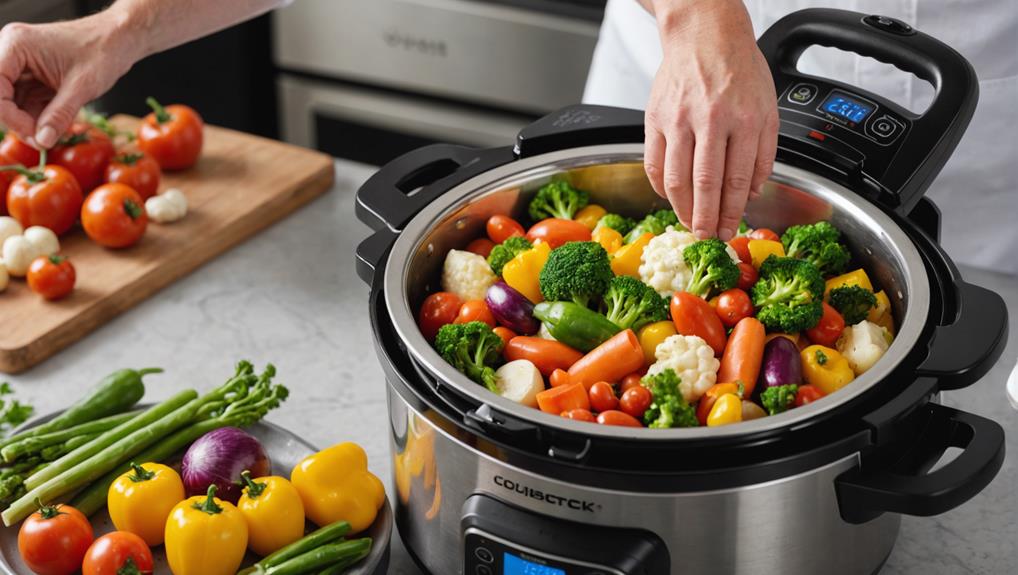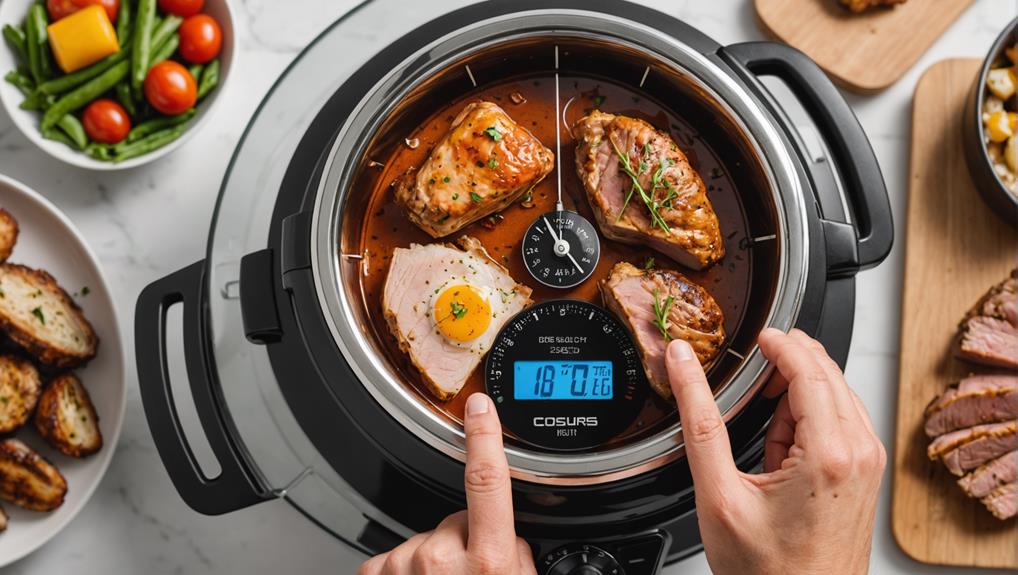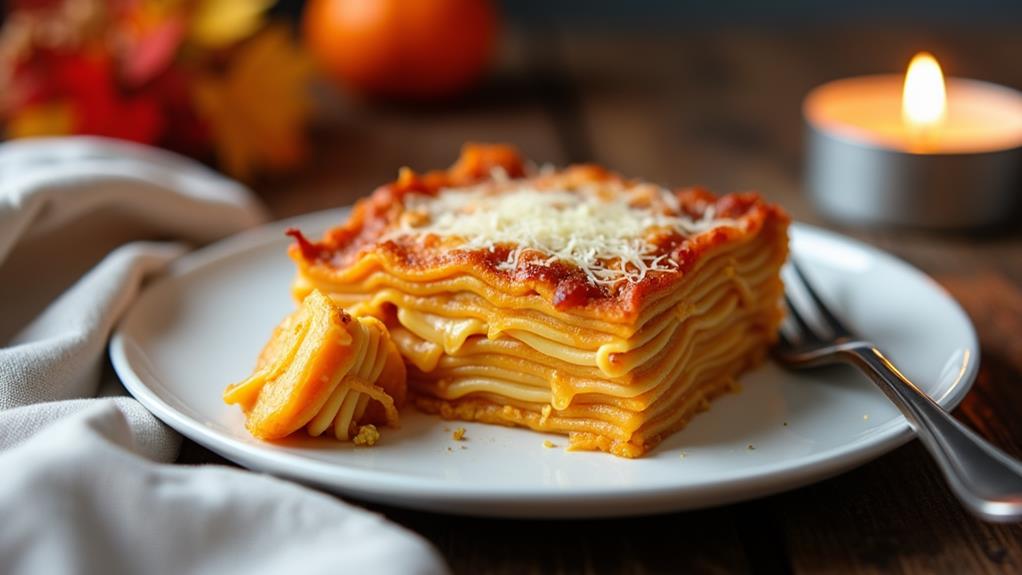To master pressure cooking times like a pro, you'll need to understand key factors that influence cooking duration. Start by familiarizing yourself with your cooker's PSI levels and adjust times accordingly. Consider food size, density, and altitude when planning your meals. For vegetables, use quick-release methods to prevent overcooking, while grains and legumes benefit from natural release. Experiment with different liquid ratios for various ingredients, and always ensure you have enough to create steam. Pay attention to meat thickness and cut uniformity for even cooking. By fine-tuning these elements, you'll be well on your way to pressure cooking perfection. The journey to culinary expertise awaits.
Understanding Pressure Cooker Basics
From the kitchen novice to the seasoned chef, understanding pressure cooker basics is essential for anyone looking to harness the power of this time-saving appliance.
Pressure cookers operate using steam pressure, cooking food 2 to 10 times faster than traditional methods. Most models work at 15 psi for optimal efficiency, but it's crucial to understand the liquid ratio. You'll need at least 1 cup of liquid to generate steam and maintain pressure, while never exceeding two-thirds of the pot's capacity.
Cooking times vary significantly based on the food type. Meats typically require 8 to 25 minutes at high pressure, while fresh vegetables often cook in under 10 minutes.
Familiarize yourself with your cooker's components, including the lid, seal, pressure regulator, and safety valve. These parts directly impact cooking performance and safety.
Regular maintenance is key to keeping your pressure cooker in top shape. Inspect the gasket and safety valve frequently to ensure safe, thorough cooking.
Factors Influencing Cooking Times
When using a pressure cooker, you'll need to consider two key factors that significantly influence cooking times: the pressure level (PSI) and the size and density of your food.
Your cooker's PSI setting, typically 12 or 15, directly impacts how long it takes to cook your food, with lower pressures requiring longer cooking times.
Additionally, the size and density of your ingredients play a crucial role, as larger, denser pieces will take more time to cook through than smaller, less dense items.
Pressure Cooker PSI Levels
Understanding pressure cooker PSI levels is crucial for achieving perfect results in your cooking. Most pressure cookers operate at 15 PSI, which allows for faster cooking times compared to lower PSI levels. For every increase in pressure, you'll generally see a 10-15% reduction in cooking time. If you're using a cooker that operates at 12 PSI, you'll need to increase your cooking times by about 20% to compensate. It's important to know your pressure cooker's specifications to make these adjustments effectively.
When working with high pressure cooking, remember that food density plays a significant role in determining cooking times. Denser foods typically require 20 to 30 minutes under pressure, while softer foods like vegetables may only need 0.5 to 10 minutes.
Electric pressure cookers often operate at slightly lower PSI levels, so you'll need to adjust cooking times accordingly. To ensure optimal results, consider factors like altitude, which can affect cooking times due to lower atmospheric pressure. For every 1,000 feet above sea level, increase your cooking time by approximately 5%.
Food Size and Density
Beyond PSI levels, food size and density play key roles in pressure cooking times. To achieve even cooking, cut your meat and vegetables into uniform pieces, ideally no larger than 1-2 inches. This consistency ensures that all ingredients cook at the same rate, preventing some from being overcooked while others remain underdone.
Dense foods, like root vegetables and tough cuts of meat, require longer cooking times compared to lighter items such as leafy greens or tender meats. When preparing a mixed vegetable medley, group similar types together and add denser items first to ensure even doneness.
For beans and legumes, consider whether they've been soaked, as this affects cooking times significantly.
Don't forget to factor in altitude when pressure cooking. For every 1,000 feet above sea level, increase your cooking times by 5%. This adjustment compensates for the lower atmospheric pressure at higher elevations.
Mastering Vegetable Cook Times

Precision is key when pressure cooking vegetables. To master cooking times, you'll need to consider factors like freshness, size, and density. For fresh vegetables, adjust your liquid amounts based on cooking duration: 0.5 cups for under 5 minutes, 1 cup for 5-10 minutes, and 2 cups for 10-20 minutes. This ensures proper steam generation and even cooking.
Most vegetables cook quickly under high pressure, typically between 0-10 minutes. Carrots need 3-4 minutes, while broccoli requires just 1-2 minutes.
Remember, frozen vegetables generally follow similar cooking times, but you may need to fine-tune based on the specific type.
To preserve texture and color, use quick-release methods after cooking. This prevents overcooking and maintains the vegetables' integrity.
Always avoid overfilling your pressure cooker and ensure a minimum of 1 cup of liquid is present to create the necessary steam.
Perfecting Grains and Legumes
When perfecting grains and legumes in your pressure cooker, you'll need to master the correct water-to-grain ratios, which vary depending on the type of grain or legume you're cooking.
Understanding soaking and cooking times is crucial, as some items like beans benefit from pre-soaking while others, such as lentils, can be cooked without this step.
Additionally, you'll want to familiarize yourself with pressure release techniques, as some grains and legumes require a natural release for optimal texture, while others can be quick-released for faster meal preparation.
Water-To-Grain Ratios Explained
Mastering water-to-grain ratios is crucial for achieving perfect results when pressure cooking grains and legumes. When using this innovative cooking method, you'll need to adjust your ratios based on the type of grain or pulse you're preparing.
For white rice, stick to a 1:1 water-to-grain ratio, while brown rice requires a slightly higher 1.25:1 ratio. Legumes like lentils don't need soaking and work well with a 1:2 ratio of lentils to water.
If you're working with soaked beans, aim for a 1:3 water-to-bean ratio and remember to use natural release for optimal tenderness.
Cooking times vary significantly, with rice taking 3-12 minutes depending on the variety, and beans requiring 20-40 minutes under high pressure.
For other grains like barley or quinoa, a 1:2 water-to-grain ratio works well. Barley typically needs 12-15 minutes, while quinoa cooks quickly in just 1-2 minutes under high pressure.
Soaking and Cooking Times
Diving into soaking and cooking times can make or break your pressure-cooked grains and legumes. When cooking under pressure, you'll find that soaked beans require significantly less time than their unsoaked counterparts. For optimal results, cook soaked beans for 6 to 8 minutes at high pressure, while unsoaked beans need 25 to 30 minutes. Lentils, on the other hand, don't need soaking and cook perfectly in 9 to 12 minutes at high pressure.
For grains, you'll want to adjust your cooking times and water-to-rice ratios accordingly. Brown rice, for instance, takes 22 to 25 minutes at high pressure with a 1:1.25 water-to-rice ratio. Heartier grains like wheat berries or barley require 30 to 40 minutes and more water—about 2 to 2.5 cups per cup of grain.
Don't forget about frozen vegetables! They're a quick and easy addition to any meal, needing just 0 to 5 minutes at high pressure with 0.5 to 1 cup of water to create sufficient steam.
Pressure Release Techniques
Now that you've got the hang of cooking times, let's focus on pressure release techniques for perfecting your grains and legumes. Mastering these methods will elevate your pressure cooking game, ensuring optimal texture and flavor in every dish.
For grains and legumes, the natural release method is your secret weapon. This technique allows for a gradual pressure drop, enhancing tenderness and preventing splitting. When cooking beans, especially soaked varieties, aim for at least 10-15 minutes of natural release post-cooking. This time allows flavors to meld while steam dissipates slowly.
While quick release is great for seafood and delicate vegetables, avoid it for legumes to maintain ideal cooking texture. Remember to adjust cooking times based on the size and type of legumes you're preparing. Black beans typically require 20-25 minutes at high pressure, while lentils need only 8-10 minutes.
Don't forget the importance of liquid in pressure cooking. Always include at least 1/2 cup for grains and legumes to ensure proper steam generation and cooking.
Timing Meats and Poultry

Three key factors influence the timing of meats and poultry in pressure cooking: the type of meat, its cut, and size.
When using your pressure cooker, remember that cooking times for beef, pork, and lamb generally range from 8 to 25 minutes at high pressure. Always include at least 1/2 cup of liquid to ensure proper pressure buildup.
For poultry, such as chicken, turkey, and duck, opt for the natural release method to maintain moisture and tenderness. This technique is crucial for achieving that perfect, juicy texture you're after.
To master the art of pressure cooking meats and poultry, keep these innovative tips in mind:
- Evenly cut meat pieces for uniform cooking
- Dry the meat before seasoning for better flavor absorption
- Choose tough cuts for optimal tenderness
- Allow roasts to rest for 10-15 minutes post-cooking
Fine-Tuning Release Methods
Mastering two primary release methods is crucial for pressure cooking success: natural release and quick release. These techniques significantly impact your final dish's texture and flavor.
Natural release, ideal for tougher meats and legumes, allows pressure to drop gradually over 10-30 minutes. This method enhances intense flavor and tenderness.
Quick release, on the other hand, is perfect for delicate foods like vegetables and seafood, preventing overcooking and preserving texture.
To optimize your cooking methods, adjust the cooking time based on your chosen release technique. Quick release often requires shorter cooking times than natural release.
Remember, pressure cookers cook food rapidly, so timing is critical. When your food is done, follow the manufacturer's instructions for safe pressure release to avoid burns.
For innovation in your pressure cooking, experiment with combining release methods. Start with a brief natural release, then switch to quick release for optimal results.
This hybrid approach can help you achieve the perfect balance of flavor and texture. By fine-tuning your release methods, you'll elevate your pressure cooking skills and create consistently delicious meals that impress even the most discerning palates.
Frequently Asked Questions
How to Calculate Pressure Cooker Times?
To calculate pressure cooker times, you'll need to master pressure cooker basics and recipe adaptation techniques. Reduce traditional cooking times by 1/2 to 2/3, adjust for pressure levels, and consider food texture variations. Don't forget cooking liquid types and pressure release methods.
How Long Do You Cook 2 Lb of Meat in a Pressure Cooker?
You're in luck! For 2 lbs of meat, you'll typically cook 20-25 minutes at high pressure. Adjust for cuts, flavor infusion, and tenderizing methods. Don't forget safety precautions and timing adjustments for altitude. Experiment with recipe variations for innovative results!
How Do Pressure Cookers Cook so Fast?
You'll find pressure cookers cook fast due to high pressure and elevated temperatures. They're safe when used correctly, but avoid common mistakes. Electric or stovetop, they require proper liquid and pressure levels. Adapt recipes and use essential tools for innovative cooking experiences.
How Many Minutes to Cook in a Pressure Cooker?
Diving into the pressure cooker world, you'll find cooking times vary like colors in a rainbow. Master pressure cooker basics, avoid common mistakes, and use essential tools. For efficiency, consult a recipe conversion guide and embrace time-saving hacks for flavorful meals.
Final Thoughts
You've now equipped yourself with the tools to navigate the high-pressure world of precision cooking. Like a skilled captain steering through turbulent waters, you'll confidently adjust times, manage releases, and create perfectly cooked meals. Remember, mastering pressure cooking is a journey of practice and refinement. With each dish, you'll fine-tune your skills, transforming raw ingredients into culinary masterpieces. Embrace the learning process, and soon you'll be pressure cooking like a seasoned pro, effortlessly crafting delicious meals in record time.















